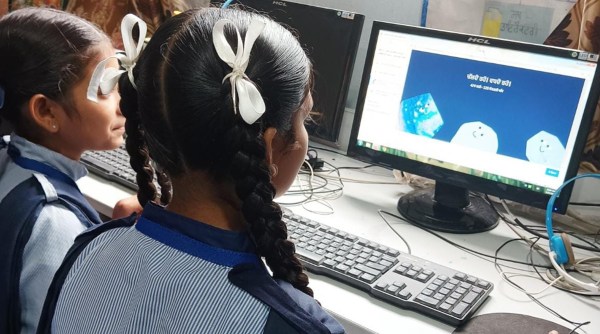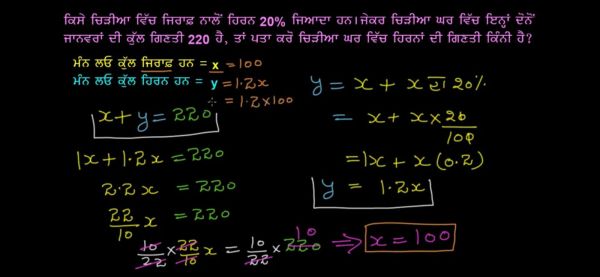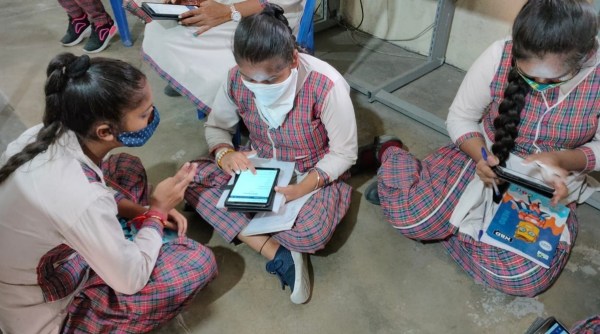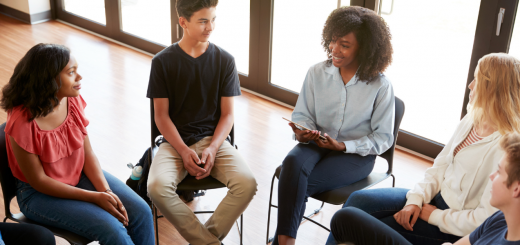Gained in translation: American Khan Academy now in Punjabi for govt school kids
When American educationist Sal Khan started Khan Academy in 2008, he would probably not have imagined the platform would eventually help government school children in rural Punjab solve maths problems — in their mother tongue, Punjabi.
A room at the Punjab Education Department’s office in Mohali was turned into a studio, with softwares for screen recording and editing, tablets with a digital pen, some laptops and a microphone. A team of 26 government teachers took on the mammoth challenge of translating Khan Academy’s entire maths content for Classes 6 to 10 into Punjabi from English. A year later, and after translating nearly 11 lakh words and creating 440 new videos, Khan Academy’s Punjabi website is now live for students and teachers to login and study, anytime, anywhere.

 The Punjabi platform can be accessed and used by any student, from any school by logging into pa.khanacademy.org. (Express Photo)
The Punjabi platform can be accessed and used by any student, from any school by logging into pa.khanacademy.org. (Express Photo)
Behind this is a memorandum of understanding signed over three years ago by Punjab’s State Council of Educational Research and Training (SCERT) and the globally acclaimed online coaching platform to help children in government schools.
Punjab has made the website fully functional in Punjabi, with over 9.5 lakh students from its government schools registered as users and 3.3 lakh of them actively using it. Every mathematics teacher also has a login ID to check students’ progress.
For Khan, who was born to a Bangladeshi father and Indian mother in the US, it all started when he had started helping his 12-year-old cousin in solving maths problems over the phone. Soon, he developed a software to help kids study online. Currently, Khan Academy reaches at least 13 crore students across 190 countries and a crore in India via video lessons and online content focusing on maths and science, which is free to use for all. It currently has 7.46 million subscribers on YouTube alone.

 A screenshot of the login page of the Punjabi version of the Khan Academy website.
A screenshot of the login page of the Punjabi version of the Khan Academy website.
To ensure that content and videos in Punjabi matched the standards and format followed by Khan Academy globally, the Punjab teachers were given training by its staff and a review process was followed before putting it on the website.
“Initially, we had signed the MoU with Punjab for piloting the project as a pilot in 180 schools in 2019, which was increased to 1,082 schools in 2021-22. It was then extended to all government schools in Punjab and localisation of our content in Punjabi was started because SCERT felt students would learn better if taught in their own language,” says Revanth Voothaluru, senior programme lead and Punjab coordinator for Khan Academy, India operations, which is working on a pro bono basis with Punjab government.
For the teachers, however, it wasn’t a simple task to ensure that while trigonometry as “tikonmiti”, statistics as “ankda vigyan” and algebra as “beejganit” are explained in the simplest possible way to the students, the standards and formats of the organisation headquartered in California were also maintained. From using a tablet instead of a blackboard for writing answers to getting familiar with screen recording software, the teachers even mastered editing software to create at least 440 new video lessons which were originally in English, covering the entire syllabus for Classes 6 to 10.
Nirmal Kaur, assistant state project director, Punjab Education Department, and nodal officer for the project, said since Khan Academy’s content for India is based on the NCERT syllabus, it made the work a bit easier. “Punjab’s SCERT also follows NCERT content so we just had to focus on translating from English to Punjabi. Our 26 teachers specialising in maths worked day and night to make it possible. While 22 worked as text translators, four were video creators. Now we have two periods fixed in a week in all schools for practising maths on this customised website and teachers can also track students using their login ID. We had transformed one of our rooms into a studio to record videos in the particular format,” she says.

 A screenshot of a Punjabi language math lesson provided by Khan Academy.
A screenshot of a Punjabi language math lesson provided by Khan Academy.
The Khan Academy follows a particular format for video lessons—there is only text and audio-visuals without the teacher visible. A student can only see an answer being scribbled on the black slate-like screen, with the audio of the teacher explaining it step-by-step. “Teachers were provided with Wacom pen tabs, laptops, microphones and two softwares— Sketchbook and Camtasia—to replicate the original format,” says Nirmal Kaur.
One of the video creators, maths lecturer Seema Sharma, explains how it works. “Initially, we had to listen to the original video at least 3-4 times as they were in a foreign accent. It was difficult for us. And then we had to record the same video in Punjabi,” she says. “We would solve the question on the tab using Sketchbook which appears like a blackboard. The text we wrote would appear on the laptop screen and get recorded with Camtasia, the screen recording software. We would explain the topic simultaneously via microphone and then final editing was done,” she says. “Sometimes we even took work home so that videos could be recorded in silence during the night.”
According to the data, compiled by Khan Academy, Punjab is leading among all the Indian states it has a collaboration with — both in terms of translation and usage.
Voothaluru says: “We are in the process of creating regional language websites for Maharashtra and Assam, but Punjab is the first where it has been completed and being used. Earlier, we had also started work in Kannada for Karnataka but the project was stopped midway due to their internal issues and it was never introduced in their schools.”

 The Punjabi version of the Khan Academy website has more than 9.5 lakh students as users. (Express Photo)
The Punjabi version of the Khan Academy website has more than 9.5 lakh students as users. (Express Photo)
The usage data shows that in Uttar Pradesh, where the academy’s Hindi content is being used in Kasturba Gandhi Balika Vidalayas (Classes 6-8), there are 7,23,000 registered students of whom 42,000 are active. In Maharashtra (Classes 1-10), there are 43,000 registered students of whom just 1,300 are active. “In Punjab there are 9.5 lakh registered students (Classes 6-12) of whom 3.3 lakh are active. We have also partnered with the Union Territory of Chandigarh and Jawahar Navodaya Vidyalayas (JNVs) but it has just started,” he added.
The MoU in Punjab was signed under the leadership of former education secretary Krishan Kumar.
Pardeep Aggarwal, Punjab’s Director General of School Education, and Maninder Sarkaria, SCERT director, who continued with the project after Kumar’s transfer, say that due to the pandemic, it was decided to focus on such platforms that can help students at home too.
However, according to teachers who are using the platform now in their schools, while it is a great initiative to introduce content in Punjabi, there were some issues on the ground restricting the usage.
“Students in government schools come from underprivileged backgrounds and do not have access to smartphones or internet at home. While we are making them practise on the Khan Academy platform in schools, they cannot complete assignments at home. They also do not have enough data packages to access videos at home. But since the content has been introduced in Punjabi, it is now reaching more students who earlier had issues with the English website,” says Manjinder Kaur, maths teacher from Government Senior Secondary School in Jhansla village of Patiala. “Some schools also have a shortage of computers,” she adds.
Yogesh Nayyar, a teacher from Ferozepur, said: “Content in Punjabi is a good initiative for rural students, but seeing current times, it is important to make them fluent in English too. We are using English and Punjabi websites both and they are enjoying learning with videos. We have 20 computers in our lab but we also show them videos on projectors.”
The Punjabi platform can be accessed and used by any student, from any school by logging into pa.khanacademy.org.



